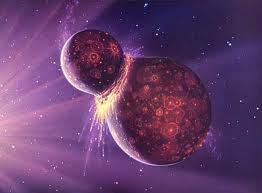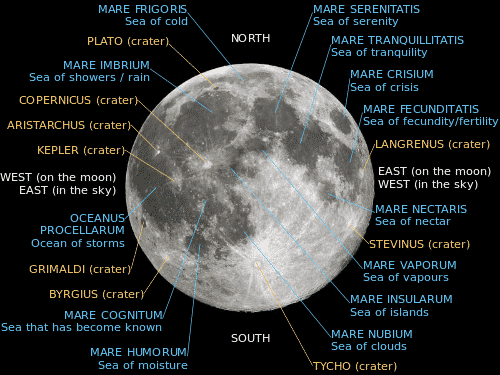*Earth’s nearest neighbor in the universe is the moon! After today’s lecture, you should be able to:
- Explain various hypotheses about how the moon formed.
- Describe features and properties of the moon.
Astronomy: the study of the universe
- The 1st probes landed on the moon in 1959.
- The 1st people landed on the moon in 1969, a mere 10 years later!
- As a result of these missions, lunar rock has been brought to Earth, which has enabled us to learn more about the history of the moon and the Earth!
There are 4 main theories about the moon’s origin:
- The Earth and moon formed at the same time, w/the moon in orbit around Earth.
- Early Earth was spinning so fast, that a chunk of it spun off into orbit.
- The moon formed elsewhere in the solar system and was later captured by Earth’s gravitational pull.
- The moon formed about 4.5 billion years ago as a result of a collision between Earth and a planet-sized object.
- This is the most widely accepted theory! (“The Impact Theory”)
- After getting hit, debris from the impact settled into orbit around Earth, and its gravity started to pull it together to form the moon.
Properties and Features of the Moon
*The moon turns on its axis in the same amount of time it takes to complete 1 orbit around the Earth, thus, the same side of the moon always faces Earth!
- 1/4 the Earth’s diameter

- 1/8 the Earth’s mass, thus causing the moon to have less gravity! (1/6 the strength of Earth’s gravity!)
- Lower density than the Earth
- For the last 3 billion years, the interior of the moon has been relatively quiet.
- Iron core is very small and not hot enough for large convection cells to carry out plate tectonics!
- Because according to the Impact Theory, the moon formed from the less-dense materials that made-up the Earth’s outer layers!
*When viewed from Earth, the moon appears as a pattern of light and dark areas.
- Dark areas are known as maria, meaning seas, because early observers thought they were looking at water.
- Rille: a trenchlike valley running through maria bedrock formed by old rivers of molten lava
- Lighter areas of the moon are known as lunar highlands, and appear brighter b/c rocks are lighter-colored and thus reflect more sunlight.
- no atmosphere to slow down flying particles
- weak gravity pulling flying particles downward
- Lunar highlands contain the oldest lunar rock, ranging in age from 4.0-4.5 billion years old.
- These lunar rocks help support the theory that the solar system (and thus the Earth and moon) formed about 4.6 billion years ago as a result of a swirling cloud of dust and debris.
- Craters: depressions in the moon’s surface formed by the impact of meteoroids
- Rays: bright streaks of shattered rock and dust that radiate out from a crater
- The moon today mainly gets hit by micrometeoroids– tiny objects no larger than sand grains
- Why doesn’t the Earth get hit by these?
- Earth’s atmosphere burns them up!
- Lunar soil is not really soil, but broken up rock material and dust called regolith.
- Contains no water, no organic material, and is formed by the smashing impact of meteoroids of all sizes.
- Earth’s atmosphere burns them up!
- Maria are flat, level basins and plains formed when the moon was still hot and molten and lava spewed up to the surface and cooled.
- Maria contain the youngest lunar rocks, ranging in age from 3.1-3.8 billion years old.
- Remember, there is no ‘rock cycle’ on the moon, so rocks can not be recycled and new rocks never form!
- Maria contain the youngest lunar rocks, ranging in age from 3.1-3.8 billion years old.
- Most lunar highlands lie at the edge of maria.
- Formed by the impact of meteoroids (rocky or icy fragments that travel through space), which thrust them up!
- How could large masses of rock be thrust up high enough to form mtns?
